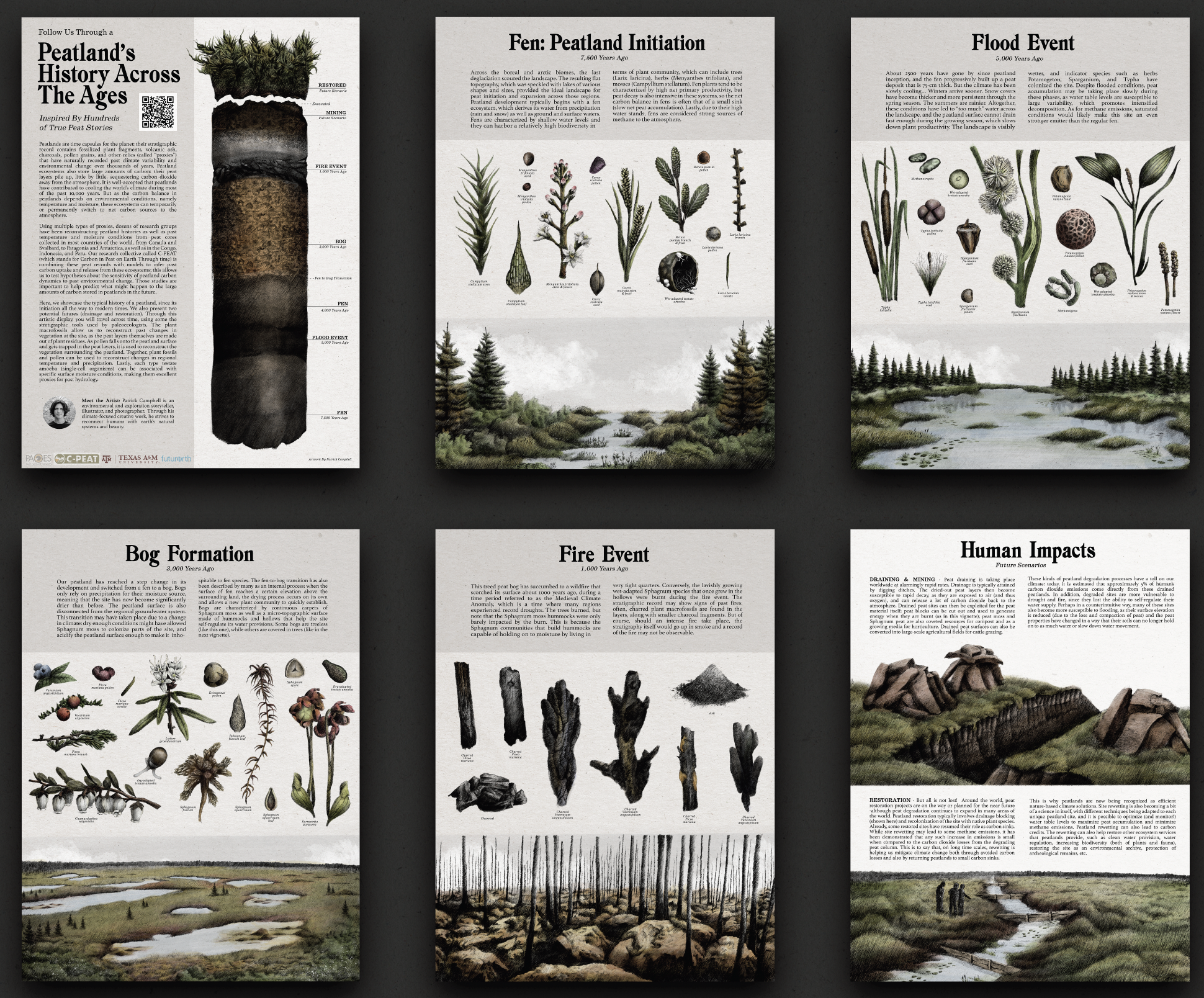- Home
- Publications
- PAGES Magazine
- C-PEAT At COP26
C-PEAT at COP26
Loisel J and Gallego-Sala A
Past Global Changes Magazine
30(1)
60
2022
Julie Loisel![]() 1 and Angela Gallego-Sala
1 and Angela Gallego-Sala![]() 2
2
United Nations Climate Change Conference (COP26), Glasgow, Scotland, 31 October - 12 November 2021
On Friday, 5 November 2021, the C-PEAT working group, in collaboration with PAGES and Future Earth, presented an exhibit during the 26th United Nations Climate Change Conference (COP26) in Glasgow, Scotland. Professors Julie Loisel and Angela Gallego-Sala (the group co-leads) gave the lecture "Getting to know peatlands, the largest natural land carbon stores on Earth", presenting updated knowledge on the global peatland carbon stocks, peatlands' sensitivity to past and future climate change, and the role of peatlands as natural climate solutions.
Peatland Pavilion
The C-PEAT lecture was hosted by the Peatland Pavilion (wedocs.unep.org/xmlui/bitstream/handle/20.500.11822/37197/COP26GP.pdf) that was organized by UNEP's Global Peatlands Initiative. The Pavilion's exhibit hall was packed with art pieces and artefacts from peatlands. The agenda was fully booked with panels and lectures for the entirety of the two-week conference. At the Pavilion, scientists and practitioners drew attention to the importance of peatlands in climate change mitigation, mainly via peatland restoration and protection. That peatlands are considered important enough to be granted a Pavilion at a COP meeting speaks volumes in itself. Their role as global cooling agents is now widely accepted; likewise, the threats these natural carbon sinks face from climate and land-use changes are also well known. Protecting peatlands has been described as "one of the most important tasks of this decade".
 |
|
Figure 1: Artistic rendition of a peatland landscape throughout its development. These six posters were presented as part of the Peatland Pavilion exhibit at COP26. Drawings by Patrick Campbell. High-resolution images available for download at julieloisel.com/cpeat. |
C-PEAT contributions
The C-PEAT group contributed an interactive peatland map (julieloisel.com/cpeat) that showcases > 75 sites from 20 countries that have been studied by the C-PEAT scientific community. The map was combined with a library of peat cores that were displayed at the Peatland Pavilion. This part of the exhibit helped attendees—both online and in-person—to appreciate where peatlands are located and what peat looks like. The map was created by Sedrick Utt, an undergraduate student researcher in the Department of Geography at Texas A&M University, USA; his work was funded by PAGES.
In collaboration with Patrick Campbell, who is an artist and peatland enthusiast, we also presented six drawings of peatland landscapes (Fig. 1), each representing a different stage in a peatland's development. For each portrait, different proxies were also drawn to represent the role of peatlands as natural archives; short texts explained how paleoecologists can reconstruct past environments and infer past landscapes from said proxies.
The talk (youtube.com/watch?v=Q4vRIefClZc) was aimed at a broad audience of informed stakeholders, practitioners, and scientists. Topics covered included: "How do we quantify the global peatland carbon stock?", "How does climate affect the peatland carbon sink?", "How will peatland extent change with warming?", and "Future research directions for C-PEAT". A PDF version of the slideshow is available (drive.google.com/file/d/1HnLJAwmJ9G3f-lmlGhC5FCXM_fwCqW4o/view); everyone is welcome to use the slides.
Achievements and concluding remarks
The Peatland Pavilion provided clear messages about the importance of restoring degraded peatlands—namely through rewetting—and protecting pristine ones. The work of peatlands as natural solutions to mitigate climate change sits well within COP26's "Glasgow Leaders' Declaration on Forests and Land Use", which was signed by more than 140 countries promising to work collectively to halt and reverse forest loss and land degradation by 2030. This pledge should be beneficial for peatlands; our interpretation is that the commitment will encompass efforts to help halt the further degradation of peatlands worldwide. In addition, countries such as Chile, Peru, Indonesia, and the DRC included peatlands in their national pledges under the Paris Agreement—known as Nationally Determined Contributions (NDCs)—for the first time. Lastly, multilateral development banks (MDBs) now consider both the extraction of peat and electricity generation from peat to be universally not aligned with the Paris goals. This is important because it may change how investments are made in terms of what is considered sustainable development, which should include the avoided conversion of peatlands.
affiliationS
1Department of Geography, Texas A&M University, College Station, TX, USA
2Department of Geography, University of Exeter, UK
contact
Julie Loisel: julieloisel tamu.edu
tamu.edu
